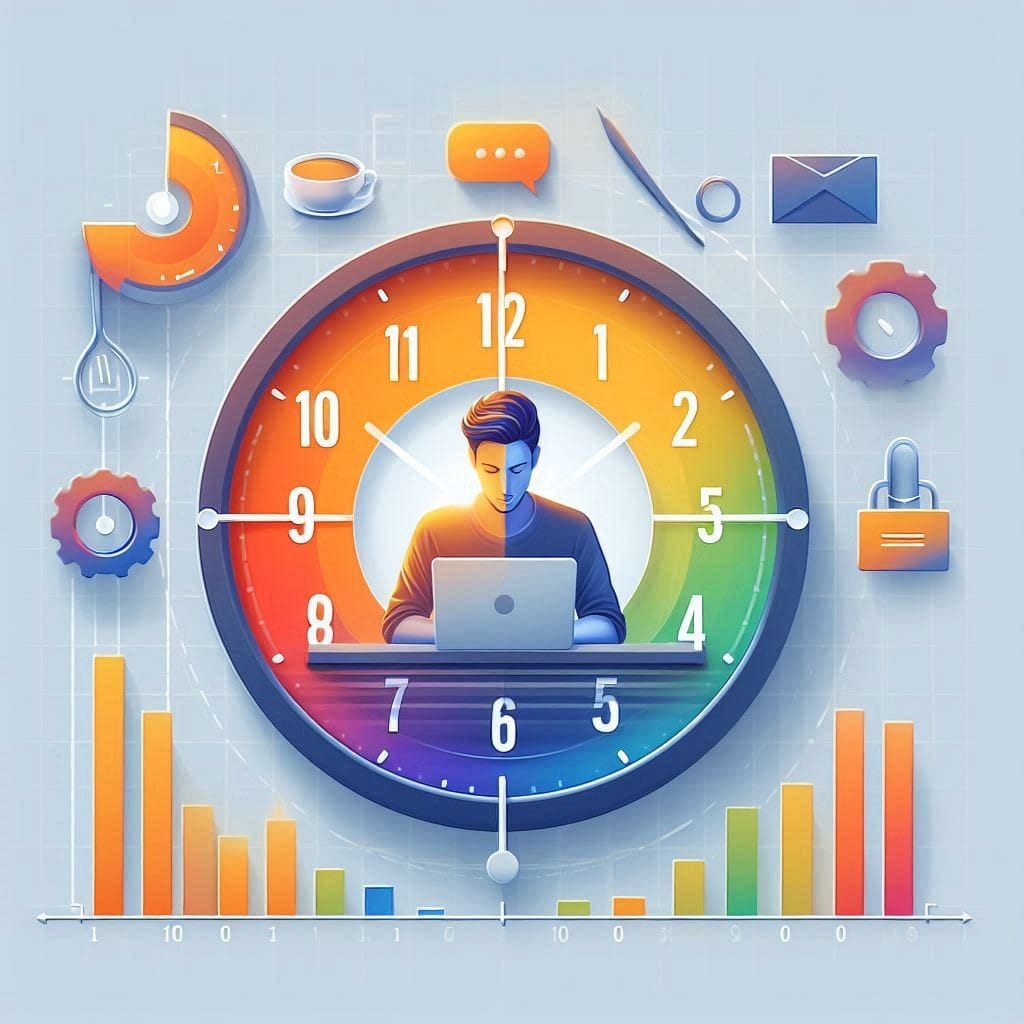Shocking Reasons You're Wasting Your Most Productive Time (And How To Fix It)
Discover science-backed strategies to identify and leverage your most productive hour. Boost efficiency, achieve more, and transform your daily routine.

To support this blog, this article contains affiliate links. For details, please see our affiliate policy.
Have you ever wondered why some days you feel like you're conquering the world, while on others, you can barely focus on simple tasks? The secret to maximizing your productivity might lie in understanding your body's natural rhythms. Imagine harnessing the power of your most productive hour – that golden window when your energy, focus, and creativity align perfectly. It's not just about working harder; it's about working smarter. But how do you identify your most productive hour of the day? Let’s find out the science behind it and uncover the strategies that will help you find and leverage your most productive hour.
Brian Tracy: "The key is not to prioritize what's on your schedule, but to schedule your priorities."
The Science Behind Your Productivity Peaks
Your body operates on a complex biological clock known as the circadian rhythm. This internal timekeeper influences everything from your sleep patterns to your cognitive function. Remember when you were a kid, and you’d magically wake up early all by yourself, ready for those exciting holiday trips?
Dr. Michael Breus, a renowned sleep expert, explains, "Understanding your chronotype – your body's natural propensity to sleep and wake at certain times – is crucial for optimizing your daily schedule." Therefore, by aligning your work schedule with your chronotype, you can increase your productivity to the next level. But it's not just about when you wake up or go to sleep. Your chronotype affects your cognitive abilities throughout the day, creating windows of peak performance unique to you.
Circadian rhythm is the internal 24-hour biological clock that regulates various physiological processes in almost all living organisms. Chronotype, on the other hand, is an individual's natural preference for sleep-wake timing and periods of peak alertness, which can vary from person to person.
Cracking the Code: How To Find Your Chronotype
So, how do you decode your personal productivity pattern? Let us start by identifying your chronotype:
- Lions (Early Birds): If you wake up early, & are most alert in the morning
- Bears (Middle of the Road): If you follow the solar cycle, & your peak performance is mid-morning
- Wolves (Night Owls): If you are most alert in the evening, & are more productive late at night
- Dolphins (Light Sleepers): If you have variable sleep patterns, often most productive mid-morning

To identify your chronotype, you can also consider the following questions:
- When do you naturally feel tired or sleepy?
- Do you prefer mornings or evenings for intense mental or physical activities?
- Do you feel more refreshed when you wake up early or when you sleep in?
- If you could sleep and wake up at your natural rhythm, what time would you go to bed?
- When during the day do you feel the most productive?
- What time do you feel most alert and energetic?
- At what times do you feel the most creative and inspired?

Action tips: "Once you understand your chronotype, you can structure your day to capitalize on your natural energy peaks and troughs." - Dr. Breus. You can also take this quiz to help you find your sleep chronotype.
Tips for maximizing productivity based on chronotype
If you are a Morning Lark:
- Rise and shine early: Make the most of your natural energy surge by waking up early and tackling high-priority tasks before lunchtime.
- Embrace the power of sunlight: Expose yourself to natural light in the morning to reinforce your circadian rhythm and boost alertness.
- Schedule meetings in the morning: Engage in collaborative activities, such as meetings or brainstorming sessions, during your peak productivity hours.
- Take a midday break: A brief afternoon nap or meditation session can help recharge your batteries and maintain focus for the rest of the day.
Get inspired: Join the Free Newsletter Now!
If you are a Night Owl:
- Stick to a consistent sleep schedule: Although you may be more alert in the evenings, it's essential to maintain a regular sleep pattern to avoid disrupting your circadian rhythm.
- Optimize your work environment: Create a comfortable and distraction-free workspace with appropriate lighting to support productivity during late hours.
- Schedule demanding tasks for the afternoon or evening: Capitalize on your natural energy surge by tackling complex projects when the brain is most alert.
- Take advantage of flexible work arrangements: If possible, negotiate a flexible work schedule that allows you to start your day later and work into the evening.
Must Read:


If you are an Intermediate Chronotype:
- Alternate between high- and low-priority tasks: To maximize both morning and afternoon productivity peaks, alternate between demanding and less-demanding tasks throughout the day.
- Identify personal energy patterns: Pay close attention to your energy levels throughout the day to identify any additional productivity peaks or dips.
- Experiment with different schedules: Test various scheduling strategies to find the most effective approach for balancing high- and low-priority tasks.
Research shows that chronotype, or a person's natural sleep-wake pattern, varies significantly with age. Babies typically have a morning chronotype, meaning they are naturally inclined to wake up early. Young adults, particularly those aged 25–34, tend to have an evening chronotype, making them more active and alert later in the day. As people reach middle and old age, the morning chronotype becomes more common again, with many older individuals preferring to wake up and be active earlier in the day.

Tips for maintaining productivity during the afternoon slump:
- Take regular breaks: Short, frequent breaks can help prevent mental fatigue and maintain focus. Try the Pomodoro Technique, which involves working for 25 minutes, followed by a 5-minute break. It is an effective way to structure your day.
- Stay hydrated and eat nutritious snacks: Dehydration and low blood sugar can contribute to afternoon sluggishness. Drink water regularly and opt for healthy snacks, such as fruits, nuts, or yogurt, to maintain energy levels.
- Practice mindfulness or meditation: Taking a few minutes to practice mindfulness or meditation can help clear your mind and increase focus. Try the RescueTime app to avoid distractions.
- Prioritize tasks: Tackle high-priority tasks during your peak productivity hours and save less demanding tasks for the afternoon, when your energy may dip.
- Connect with others: Engaging in conversation or collaborating on a project can help increase motivation and productivity during the afternoon slump.
According to research, disruptions to our natural sleep-wake cycle, whether due to voluntary reasons like shift work or travel or involuntary reasons like illness or aging, can lead to various mental and physical health issues. These disruptions can also negatively affect safety, performance, and productivity.
Mapping Your Productivity Landscape
Now that you've identified your chronotype, it's time to map out your day. This process involves more than just knowing when you feel most awake. It's about understanding the nuances of your cognitive function throughout the day.

The Peak-Trough-Rebound Cycle
Daniel Pink, author of "When: The Scientific Secrets of Perfect Timing," introduces the concept of the peak-trough-rebound cycle. This pattern suggests that most people experience:
- A peak (sharp increase in mood and alertness)
- A trough (significant dip in performance)
- A rebound (recovery of mood and performance)
The timing of these phases varies based on your chronotype. For instance, Lions might experience their peak early in the morning, while Wolves hit their stride in the late afternoon or evening. Once you identify your chronotype, time your daily work accordingly between the 3 patterns.
Elevate your day: Free insights every week. Sign up now!
Tracking Your Productivity Pulse
Actionable Tip: To pinpoint your most productive hour, try this experiment:
- For one week, set hourly reminders on your phone.
- When the reminder goes off, rate your energy, focus, and mood on a scale of 1-10.
- Note the type of tasks you're working on and how efficiently you're completing them.
- At the end of the week, analyze your data to identify patterns.
Must Read:


Optimizing Your Schedule for Peak Performance
Once you've identified your most productive hour, it's time to make the most of it. Here's how to structure your day for maximum efficiency:
1. Guard Your Golden Hour: Treat your peak productivity time as sacred. Schedule your most important, high-cognitive tasks during this period. As management consultant Peter Drucker once said, "Until we can manage time, we can manage nothing else."
2. Batch Similar Tasks: Group similar activities together to minimize context switching. For example, if you're most creative in the morning, use that time for brainstorming and content creation, saving administrative tasks for your lower-energy periods.
3. Use Time-Blocking Techniques: Implement the Pomodoro Technique or time-blocking methods to maintain focus during your productive periods. These strategies can help you make the most of your energy peaks and manage your energy dips more effectively. Try RescueTime To Take Back Control of Your Time.

Beyond the Hour: Holistic Productivity Optimization
While identifying your most productive hour is crucial, true productivity optimization extends beyond a single time slot. Consider these additional factors:
Environmental Influence
Your physical environment plays a significant role in your productivity. A study by the University of Exeter's School of Psychology found that employees working in well-designed spaces reported a 32% increase in productivity.
Actionable Tip: Create a dedicated workspace that minimizes distractions and promotes focus. Consider using Notion to organize your digital workspace and streamline your workflow. Read more about Notion here.
Transform your week with the free newsletter. Sign up today!
The Role of Technology
In our digital age, technology can be both a blessing and a curse for productivity. While tools like RescueTime can help you track and optimize your time usage, constant notifications can derail your focus. Dr. Gloria Mark, a professor of informatics at the University of California, Irvine, notes, "It takes an average of 23 minutes and 15 seconds to get back to a task after an interruption."
Actionable Tip: Use NordVPN to create a distraction-free online environment during your peak productivity hours, blocking access to time-wasting websites.
Continuous Learning and Skill Development
Enhancing your skills can significantly boost your productivity. Platforms like Upskillist and Masterclass offer courses that can help you upskill and work more efficiently.
Actionable Tips for Productivity Mastery
- Craft a Morning Routine: Start your day with intention. Even if you're not a morning person, a consistent routine can set a productive tone for the day.
- Set Clear Goals: To set objectives, use the SMART (Specific, Measurable, Achievable, Relevant, Time-bound) framework. Learn more at atlassian.com.
- Practice Mindfulness: Incorporate meditation or deep-breathing exercises to improve focus and reduce stress. Apps like Headspace & Calm can guide you through short, effective sessions.
- Outsource When Possible: Platforms like Fiverr Marketplace allow you to delegate tasks that don't require your personal attention, letting you focus on high-value activities.

Remember, productivity is not about doing more; it's about achieving more. By aligning your tasks with your natural rhythms and implementing these strategies, you'll not only find your most productive hour but also create a sustainable system for peak performance throughout your day.
Conclusion
Finding your most productive hour is more than just a time management hack – it's a gateway to a more fulfilling and efficient life. By understanding your chronotype, tracking your energy levels, and optimizing your environment, you can unlock unprecedented levels of productivity and creativity.
Remember, this is a personal journey. What works for others may not work for you. Just be patient and persistent in your experimentation. The rewards of aligning your work with your natural rhythms are well worth the effort.
TAKE ACTION NOW - Start by tracking your energy levels for the next week. Use the insights you gain to restructure your day, prioritizing your most important tasks during your peak hours. With time and practice, you'll find yourself accomplishing more than you ever thought possible, all by working in harmony with your body's natural rhythms.
Join The Newsletter Community Today !!!
Enjoying the content? Your support helps me continue creating valuable insights.
Stay up-to-date with my latest content by subscribing to my free weekly newsletter directly in your Inbox.
References
- Kalmbach, David A, et al. “Genetic Basis of Chronotype in Humans: Insights from Three Landmark GWAS.” Sleep, vol. 40, no. 2, 9 Dec. 2016, www.ncbi.nlm.nih.gov/pmc/articles/PMC6084759/, https://doi.org/10.1093/sleep/zsw048. Accessed 22 July 2024.
- Lack, None. “Chronotype Differences in Circadian Rhythms of Temperature, Melatonin, and Sleepiness as Measured in a Modified Constant Routine Protocol.” Nature and Science of Sleep, 1 Nov. 2009, pp. 1–1, www.ncbi.nlm.nih.gov/pmc/articles/PMC3630920/, https://doi.org/10.2147/nss.s6234. Accessed 22 July 2024.
- Vitaterna, M H, et al. “Overview of Circadian Rhythms.” Alcohol Research & Health : The Journal of the National Institute on Alcohol Abuse and Alcoholism, vol. 25, no. 2, 2001, pp. 85–93, www.ncbi.nlm.nih.gov/pmc/articles/PMC6707128/. Accessed 22 July 2024.
- Zou, Haowen, et al. “Chronotype, Circadian Rhythm, and Psychiatric Disorders: Recent Evidence and Potential Mechanisms.” Frontiers in Neuroscience, vol. 16, 10 Aug. 2022, www.ncbi.nlm.nih.gov/pmc/articles/PMC9399511/, https://doi.org/10.3389/fnins.2022.811771. Accessed 22 July 2024.
- “Take the Chronotype Quiz.” Sleep Doctor, 13 Dec. 2022, sleepdoctor.com/sleep-quizzes/chronotype-quiz/. Accessed 22 July 2024.
- Robinson, Debbie. “Featured News - University of Exeter.” Exeter.ac.uk, 2024, news-archive.exeter.ac.uk/featurednews/title_98638_en.html#:~:text=People%20working%20in%20enriched%20spaces,without%20any%20increase%20in%20errors. Accessed 22 July 2024.
- Boogaard, Kat. “How to Write SMART Goals (with Examples).” Work Life by Atlassian, 26 Dec. 2023, www.atlassian.com/blog/productivity/how-to-write-smart-goals#:~:text=What%20are%20SMART%20goals%3F,within%20a%20certain%20time%20frame. Accessed 22 July 2024.
